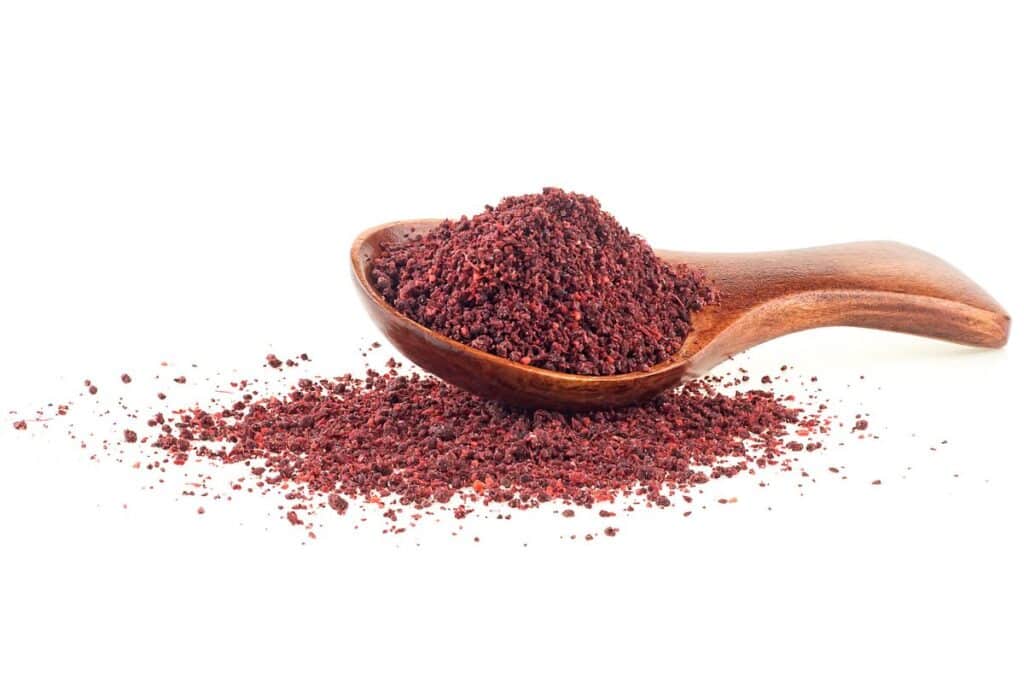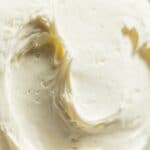Quick summary: Best sumac alternatives are lemon zest or juice, lime juice, and lemon pepper seasoning. But tamarind, vinegar, cumin, and other exciting ideas can also come in handy depending on what flavor your recipe requires.
Sumac spice is popular in Middle Eastern cooking. This red spice adds a lemony zing to dips, marinades, and dressings.
Unless you cook a lot of Lebanese, Middle Eastern, or Arabic cuisine, this is probably not a spice you commonly keep in the pantry.
If your recipe calls for sumac and you don’t have any, or can’t find any at your local grocery store, don’t just leave it out. There are a few quick fixes to get the same punchy flavor in your dish.
In this guide, we’ll provide you with some easy sumac substitutes that you likely already have at home.
What is Sumac?
Sumac comes in two types. Poisonous sumac is white while the culinary herb (which is completely safe to eat) is red. The little red berries are mostly available as a ground spice, however, they can also be found as dried whole sumac berries.
The spice adds a red tinge to dishes. It has a sweet and sour taste similar to lemon juice, followed by an astringent punch. Just like salt, when added in the right quantity, sumac brings out the natural flavors of the food it is added to.
It is one of the common spices in Za’atar, a Middle Eastern spice blend. It also pairs well with chili, thyme, cumin, and allspice.
How to Use Sumac
Sumac is a versatile spice and can be used to add a lemon flavor without having to add liquid to a recipe. It can bring a bit of acidity to cut through fatty meats such as duck and lamb and is great to sprinkle over a meal just before serving.
The spice is wonderful with vegetable dishes, stews, dry rubs, salad dressings, dips, sauces, and grilled meats. Like lemon, it naturally goes well with fish and chicken dishes, and can be added to bread dough and meatloaf mix.
Before adding sumac to your recipe, check the label. Some manufacturers add salt to the blend. If the spice contains salt you will want to decrease salt elsewhere in the recipe.
Best Substitutes for Sumac
Lemon zest
Our number one substitute for sumac is not only a great flavor match but also very easy to find. Lemon zest has the same sour acidic notes which makes it ideal.
It is a good sumac substitute for chicken dishes and shellfish. To accentuate the flavor you can add a small pinch of salt when using lemon zest as your replacement.
If your recipe calls for one teaspoon of sumac, replace it with 1 ½ teaspoons of lemon zest with a touch of salt.
Lemon Juice
If you don’t have a lemon you can zest at home, but have a bottle of lemon juice in the fridge, you can use this to get that citrusy, sour flavor in your dish. As with the zest, you can optionally sprinkle a small pinch of salt with the lemon juice to balance the bitterness.
One thing to remember when using the juice is that the acidity will cause some dairy-based sauces to curdle if added during cooking. It is therefore best used with grilled meat, fish, vegetables, and salad dressing or squeezed over dishes just before eating.
Add a small amount to your dish as a replacement and then adjust to taste.
Different shelf life rules for lemon juice apply to freshly squeezed or purchased ones. Read more to learn the difference and get storage tips.
Lime Juice
Limes have a different flavor to lemons. However, if you don’t have fresh lemon juice on hand, but have lime juice, give it a try. It will add the sour and acidic punch you are looking for.
As with lemon juice, start with a small squeeze and add to taste.
Read more on lime juice durability and how to store it best.
Lemon Pepper Seasoning
Lemon pepper seasoning can be bought with other spices in most grocery stores. It is made of cracked black pepper and dried lemon zest and has a great citrusy taste with subtle peppery heat.
It makes a delicious replacement in almost all recipes from dips and dressings to pita’s, meat rubs, marinades, roast vegetables, and stews.
To get a similar balance, use one and a half times the amount required in your recipe. If your recipe calls for one teaspoon, use 1 ½ teaspoons of lemon pepper seasoning.
Za’atar
Since sumac is one of the ingredients in this spice blend, you will be guaranteed to get very similar flavor notes. However, Za’atar also contains a mix of other herbs including dried oregano, thyme, marjoram, and toasted sesame seeds.
Make sure the other flavors pair well with your dish. Considering the type of recipes that usually contain sumac (Mediterranean and Middle Eastern dishes), you should have no problem using this as an excellent replacement.
It is especially great as a meat rub or seasoning for fish and chicken as well as pairing with grilled vegetables and dips.
When using spice blends like Za’atar as a substitute, you can use it to replace more than one spice or herb at a time.
For example, if your recipe calls for sumac and oregano, you can use Za’atar as a replacement for both ingredients. Using Za’atar and adding oregano again separately will throw off the balance of flavors.
Replace Za’atar in equal quantities. If desired, add a little more to taste.
Vinegar
With its high acidity, vinegar is another pantry staple that you can easily grab in a pinch. Apple cider vinegar or rice wine vinegar are some of the best types to use and will add a touch of sweetness in addition to the light fruity notes.
Vinegar is very punchy, so you will only need half the amount your recipe calls for. It is best used in salad dressings, non-dairy sauces, and can be used sparingly in marinades.
Vinegar is not suitable to sprinkle over your finished dish like you would lemon juice since the acidity will overpower other flavors.
Keep in mind that it will cause dairy-based sauces or soups to curdle, so use a different option in these cases.
If using vinegar that’s been outdated, check the signs of spoilage to determine if it is still okay. Apple cider vinegar has a pretty long shelf life, so it’s probably okay after the expiration.
Tamarind
Tamarind is a tropical fruit with a sour taste. It is commonly found in south-east Asian and Indian cuisine. The fruit comes in dried pods but can often be purchased in a paste form in stores. It lacks the citrus notes but gives you a similar sourness with a sweet undertone.
You can mix a small amount of the paste into stews, curries, and marinades. Remember that the paste is concentrated so you will want to use less to begin with and add to taste.
Amchoor
Amchoor (amchur) is not a common spice in many parts of the world, but if you happen to have this in the pantry it will work well as an alternative in your recipe.
The light brown dry mango powder is made from unripe mango flesh and has a sour taste with a touch of sweetness. The acidic flavor makes it a good choice to pair with poultry and fish dishes although it won’t give you the same red color.
Cumin
Cumin is a common pantry spice and is often used in a variety of global cuisines, especially Indian, Middle Eastern, and African recipes.
Although the spice has citrus notes it has a warm and earthy profile. It may alter the flavor of your dish somewhat since it is not as acidic and has a slight bitterness. You also won’t get the same red pop of color.
It’s a good option for meat dishes, spice rubs, stews, curry, rice dishes, and vegetables. You can replace ground cumin in equal quantities, however, since the flavor profile is a little different, we recommend starting with just a little less and adding to taste.
FAQ
Although both spices are red, they don’t taste the same. Paprika is thus not a suitable substitute. You can add paprika just to get a tinge of red, however, it will affect the flavor of your dish.
Despite its red color that may give you the impression that sumac is spicy hot, it won’t add any heat to food like chili or cayenne pepper does.
Keep your spices in an airtight container in a cool dry place, out of direct sunlight. When spices are exposed to air, light, and moisture the flavor intensity will decrease.
Sumac is a unique spice that brings a citrusy burst and tangy flavor to a range of recipes from fish and poultry dishes to vegetables, dips, grilled meat, and dressings.
Although none of the substitutes will be an exact sumac flavor match they will provide similar acidic and fruity notes.
When choosing a substitute, consider whether using a liquid such as lemon juice or vinegar will affect the consistency of your dish.
With such punchy flavors, we always recommend starting with less and adding to taste. This will prevent causing irreparable damage by overpowering other delicate flavors.
The great thing is, that you can adjust the acidity level to exactly the way you like it!
Happy Cooking!
*image by domnitsky.yar/depositphotos









